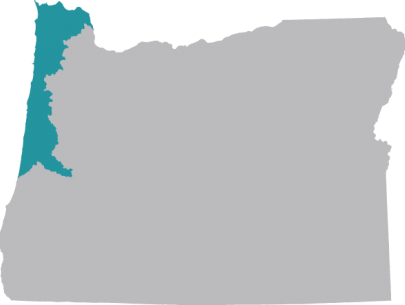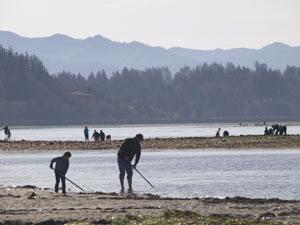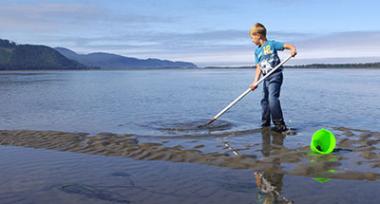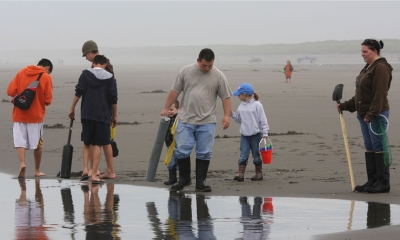
Northwest Zone
The northwest zone provides many opportunities for crabbing and clamming. This zone encompasses Clatsop beaches, Nehalem Bay, Tillamook Bay, Netarts Bay, Nestucca Bay, Siletz Bay, Yaquina Bay, Alsea Bay and Siuslaw River.

For your safety, call the Oregon Department of Agriculture Shellfish Safety Hotline before harvesting any shellfish at 1-800-448-2474 or check their website.
Regulation Highlights
Razor clams
- Daily limit of first 15 dug (no sorting or releasing).
- Razor clams may be taken by hand, shovel, clam gun or tube with opening no less than 4” (cylindrical) or 4” X 3” (elliptical).
- Razor clams are closed July 15 to Sept. 30 north of Tillamook Head (Clatsop County) for annual conservation closure.
- Before heading out, always check the weekly Recreation Report to see which areas of the coast are currently open or closed for razor clamming.
Bay clams (butter, littleneck, gaper, and cockle)
- Daily limit of 20 in aggregate, only 12 may be gapers.
- Must take first 12 gapers (no sorting or releasing).
- May be taken by hand or hand-powered tools.
Purple varnish clams
- Daily limit of 72.
Other Clams (softshell, piddocks and others not listed)
- Daily limit of 36 in aggregate.
- Must take first 36 softshells (no sorting or releasing).
Dungeness crab
- Daily limit of 12 (males only)
- Minimum size of 5 ¾ inches. Correct size is measured as a straight line across the back (caliper measurement) in front of, but not including the points.
- Bays, beaches, estuaries, tide pools, piers and jetties are open for crabbing all year, 24 hours per day.
- Ocean waters are closed for crab Oct. 16 – Nov. 30.
- May be taken using crab rings, baited lines, or pots (limited to 3 rings/lines/pots total, per person); by hand, dip net, or rake.
Red rock crab
- Daily limit of 24 of any size or sex.
- May be taken using crab rings, baited lines, or pots (limited to 3 rings/lines/pots total, per person); by hand, dip net, or rake.
- Bays, beaches, estuaries, tide pools, piers and jetties are open for crabbing all year, 24 hours per day.
- Ocean waters are closed for crab Oct 16-Nov 30.
Please check the sport fishing e-regulations Marine Zone for all the shellfishing limits and laws.
European green crab
- Daily limit of 35 of any size or sex.
- Bay, beaches, estuaries, tide pools, piers and jetties are open for crabbing all year, 24 hours per day.
- Ocean waters are closed for crab Oct 16-Nov 30.
- May be taken using crab rings, baited lines, or pots (limited to 3 rings/lines/pots total, per person); by hand, dip net, or rake.
- Identified by five spines on the outside of each eye, with three bumps between the eyes.
Crabbing in the Northwest Zone
You can crab by boat, dock, or shore in the northwest zone. There are areas in several bays to drop a crab pot, ring, or baited line and pull up Dungeness or red rock crab.
Razor clamming in the Northwest Zone
Razor clams are found throughout Oregon’s ocean beaches. Clatsop beaches have the most stable populations. Other area’s such as, Agate Beach, Waldport Beach, Whiskey Run, Myers Creek and other beaches along the coast also have razor clam populations, but tend to be less available.
Bay clamming in the Northwest Zone
Oregon estuaries are rich with many species of clams, although only a few of these species are commonly harvested. Gaper, butter, cockle, littleneck and softshell are primarily harvested due to their abundance, size and taste.
Clatsop beaches: Around 95 percent of Oregon's razor clam digging occurs on beaches from the Columbia River to Seaside.
- Very popular for razor clamming from Oct. 1- July 14 each year.
Nehalem Bay: Located on Hwy 101 60 miles north of Lincoln City and 40 miles south of Astoria. It is surrounded by the towns of Manzanita, Nehalem and Wheeler.
- There are large mud flats here that are only accessible by boat. They contain mostly softshell clams which can be captured with a shovel or clam gun.
- Softshell and purple varnish clam areas can be accessed by boat or by walking in from Nehalem Bay State Park.
- Boat crabbing is available all throughout the channel.
Tillamook Bay: Known for having it all, including shellfishing!
- Bay clams, including butter clam, gapers, softshells, and cockles can be found here.
- Some razor clams are in the north end of the bay.
- There is also boat crabbing in the bay.
Netarts Bay: A boat basin is located in the town of Netarts at the north end of Netarts Bay Drive. The jetties around the boat basin also offer some bank crabbing using rod and reel set-ups.
- Gaper and cockle clams, littleneck, softshell, and butter clams can all be found here.
- Dungeness and red rock clams are available by boat and along a few shorelines.
Nestucca Bay: Just south of Pacific City, and home to the beautiful Nestucca Bay National Wildlife Refuge.
- Boat crabbing is available close to the ocean.
- Mud flats which can be accessed by boat or on foot are good for softshell clamming.
Siletz Bay: Located at the south end of Lincoln city, Siletz Bay is a very popular destination for beach-goers and clam diggers. Some of the highest density purple varnish clam beds are easily accessed here. Its proximity to the ocean also makes it a very productive seasonal crabbing area.
- Purple varnish clams are abundant and easily dug in the lower bay. Softshell clams can be found mixed in those lower bay beds, but also are found in the upper bay, for example near the Hwy 101 bridge.
- Shoreside crabbing can be pursued both from the bank on the north side of the mouth of the bay and from the public fishing pier. The bank is better at lower tides when gear can be thrown into deeper water. At high tides, water covers the beaches and the best access is the pier directly in front of Mo's.
- Dungeness crabbing in the summer to early winter can be good. Limited area can be found near the mouth of Siletz Bay. Use extra caution when boating near the ocean. Tidal currents can be extreme and sneaker waves can swamp boats.
Yaquina Bay: Lower Yaquina bay is "marine dominated", meaning there is little freshwater influence, and offers many shellfishing opportunities.
- All species of bay clams are found in abundance in lower Yaquina Bay, tideflats are large and easily accessible. In upper Yaquina Bay, where marine influence and salinity is lower, softshell clams are found on soft, muddy flats.
- Dock crabbing in Yaquina Bay is popular at the public pier located in South Beach and along Newport's Bayfront. Crabbing is best in the summer and fall using rings and lightweight folding traps.
- Crabbers with boats set gear in many locations within Yaquina Bay. Boats can be launched at the South Beach marina or rented from several locations.
Alsea Bay: Just a few miles south of Newport, the town of Waldport (population 2,000) is on the shores of Alsea Bay. It is one of Oregon’s estuaries that does not have jetties at the ocean entrance. Strong outgoing tides and ocean swell can make boating near the mouth of the bay more dangerous. Use caution and be prepared if you crab in this area.
- Cockles and purple varnish clams can be found in the areas nearest the ocean. A little further up the bay, softshell clams are found.
- Dungeness crabbing in the summer to early winter is very good. However, significant rain events can quickly lower the salinity in the bay and prompt crab to move out to the ocean.
- Dock crabbing can be found next to the Port of Alsea docks. Crab casting devices can be successful near the ocean outlet where there's access to deep water close to the shore.
- Boat crabbing is seasonally excellent in areas west of the power lines.
Siuslaw River: The Siuslaw river runs past the city of Florence and then flows for 4 miles to the Pacific ocean. Areas west of the 101 bridge feature excellent seasonal crabbing and even some good diving.
- Softshell and purple varnish clams can be found here.
- Dungeness crabbing in the summer to early winter is very good. Dock crabbing can be pursued from the public docks along the Florence waterfront. Crab casting devices can be successful near the ocean outlet where there's access to deep water close to the shore.
- Boat crabbing is seasonally excellent west of the Hwy101 bridge.



